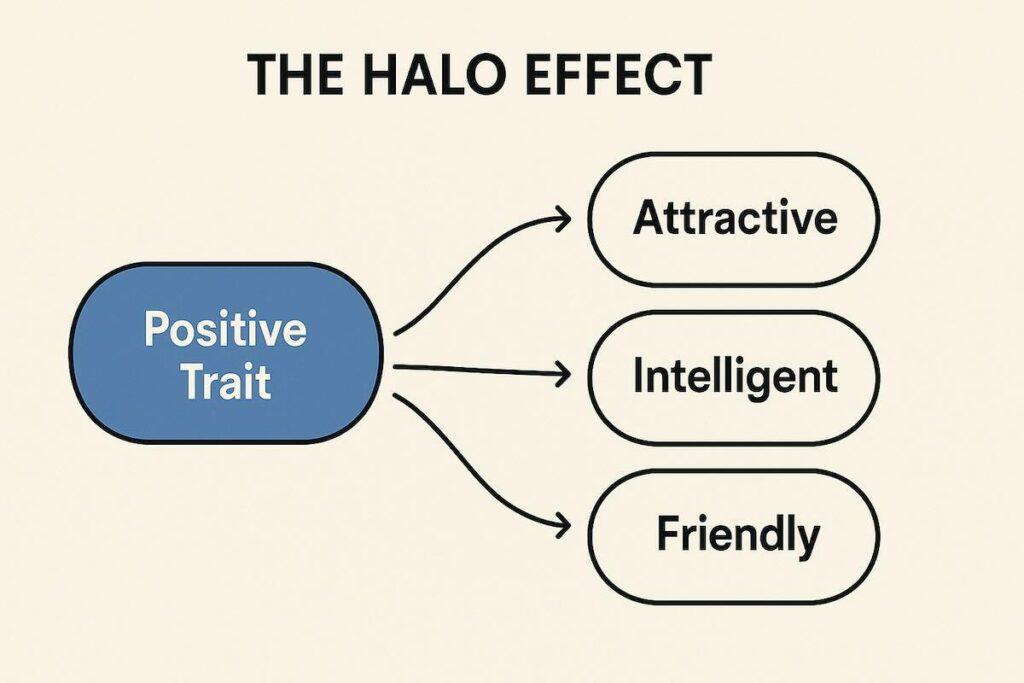This bias makes us focus on one positive trait and overlook the rest. It’s seen in psychology, marketing, education, and leadership. It shows how our decisions can be influenced by our own biases.
In this article, we’ll explore the halo effect. We’ll see how it distorts our thinking and how to fight it. We’ll use real strategies to make better choices.
What is the Halo Effect Mental Model?
The halo effect mental model is a cognitive bias that occurs when our overall impression of a person, company, or product influences how we feel about their specific traits or characteristics.
In simpler terms, it’s the tendency to let one positive quality create a “halo” that enhances our perception of other unrelated qualities.
The halo effect mental model: How one positive trait influences perceptions of unrelated qualities
Psychologist Edward Thorndike first identified this phenomenon in 1920 in his paper “A Constant Error in Psychological Ratings.” He observed that when military officers rated their subordinates, high ratings in one characteristic (such as physical appearance) correlated strongly with high ratings in unrelated characteristics (such as intelligence or leadership).
“The estimates of the same man in a number of different traits such as intelligence, industry, technical skill, reliability, etc., were very highly correlated and very evenly correlated.”
This observation led Thorndike to conclude that people tend to view others holistically—as either all good or all bad—rather than evaluating individual traits independently. The reverse is also true: a single negative trait can create a “horn effect” that negatively influences our perception of other qualities.
Real-World Examples of the Halo Effect Mental Model
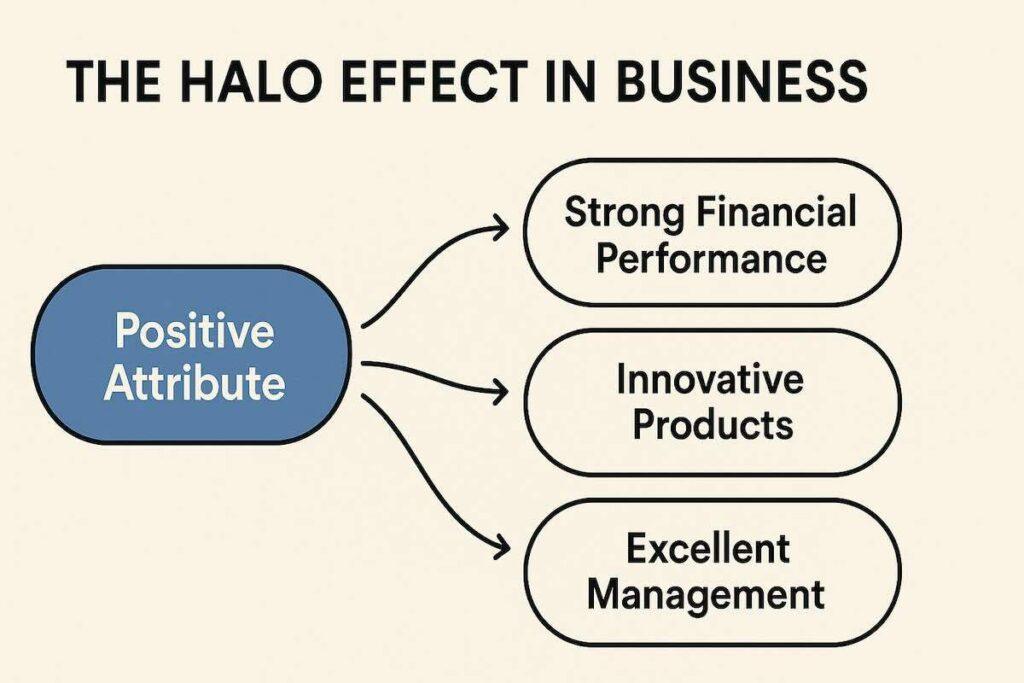
The Halo Effect in Business
The business world is rife with examples of the halo effect mental model. Consider these common scenarios:
- Brand Extensions: When Apple, known for its innovative computers and phones, released the Apple Watch, consumers assumed it would be equally revolutionary—before any reviews were available.
- Hiring Decisions: Research shows that attractive candidates are often perceived as more competent and are more likely to be hired, regardless of actual qualifications.
- Leadership Perception: CEOs of successful companies are often attributed with exceptional leadership skills, even when their success might be due to market conditions or predecessor groundwork.
- Product Pricing: Premium-priced products are frequently assumed to be of higher quality, even when objective measures show no difference from lower-priced alternatives.
The Halo Effect Mental Model in Education

Teachers may unconsciously form expectations about students’ academic abilities based on unrelated traits
A landmark study by Rosenthal and Jacobson (1968) demonstrated that teachers’ expectations of students significantly influenced student performance (Pygmalion Effect). When teachers were told certain randomly selected students were “intellectual bloomers,” these students showed greater academic improvement—simply because teachers expected them to.
More recent research has found that teachers often rate well-behaved students as more intelligent before objectively evaluating their academic abilities. Similarly, students tend to rate instructors who are warm and friendly as more knowledgeable and competent in their subject matter.
The Halo Effect in Personal Relationships
The halo effect shapes our personal relationships in profound ways:
- Dating Preferences: Attractive individuals are often assumed to have better personalities, higher moral standards, and greater intelligence—what researchers call the “what is beautiful is good” stereotype.
- First Impressions: A single positive interaction can create a lasting positive impression that colors all future interactions with that person.
- Celebrity Endorsements: We trust product recommendations from celebrities we admire, even when they have no relevant expertise in the product category.
The Halo Effect in Consumer Psychology and Branding
The halo effect mental model is very strong in how we shop. Brands use it to make us think their products are better. For example, when Apple releases a new item, many people think it’s top-notch without checking it out.
Studies back this up. A study showed that people like products more if they’re from famous brands. Even if the products are the same, the brand’s reputation makes a difference.
This can lead to problems. We might ignore bad products or pay too much because we trust the brand. Knowing about the halo effect helps us make smarter choices when we buy things.
Critical Analysis: The Pros and Cons of the Halo Effect Model
Advantages
- Enables quick decision-making in complex situations
- Reduces cognitive load when processing new information
- Can build positive momentum in relationships and teams
- Helps brands leverage existing goodwill when expanding
Disadvantages
- Leads to unfair judgments and missed opportunities
- Creates blind spots in evaluation and assessment
- Reinforces existing biases and stereotypes
- Can result in poor decision-making in critical situations
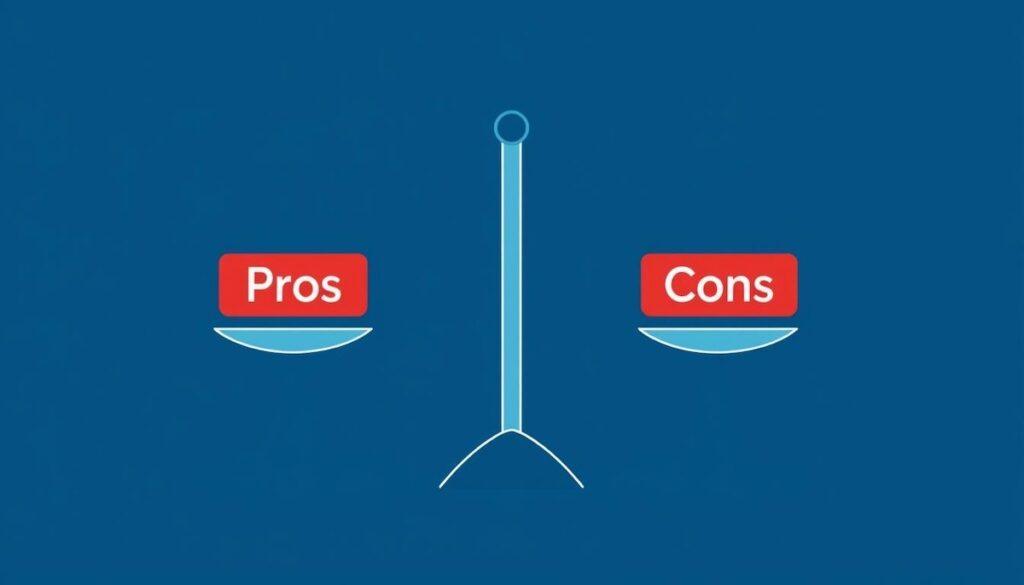
Weighing the advantages and disadvantages of the halo effect in decision-making
The Halo Effect Mental Model: The Science Behind the Bias
From a cognitive science perspective, the halo effect is a form of confirmation bias. Once we form an initial impression, we tend to seek and interpret information that confirms this impression while ignoring contradictory evidence.
Neuroimaging studies suggest that when we encounter someone with one positive trait, the brain’s reward centers activate, creating a positive emotional state that influences subsequent judgments. This happens largely outside our conscious awareness, making the halo effect particularly difficult to overcome.
Key Insight: The halo effect operates most strongly when we have limited information about a person or situation. As we gather more specific data points, the effect typically weakens—though it rarely disappears completely.
Neurological Insights: How the Brain Creates the Halo Effect
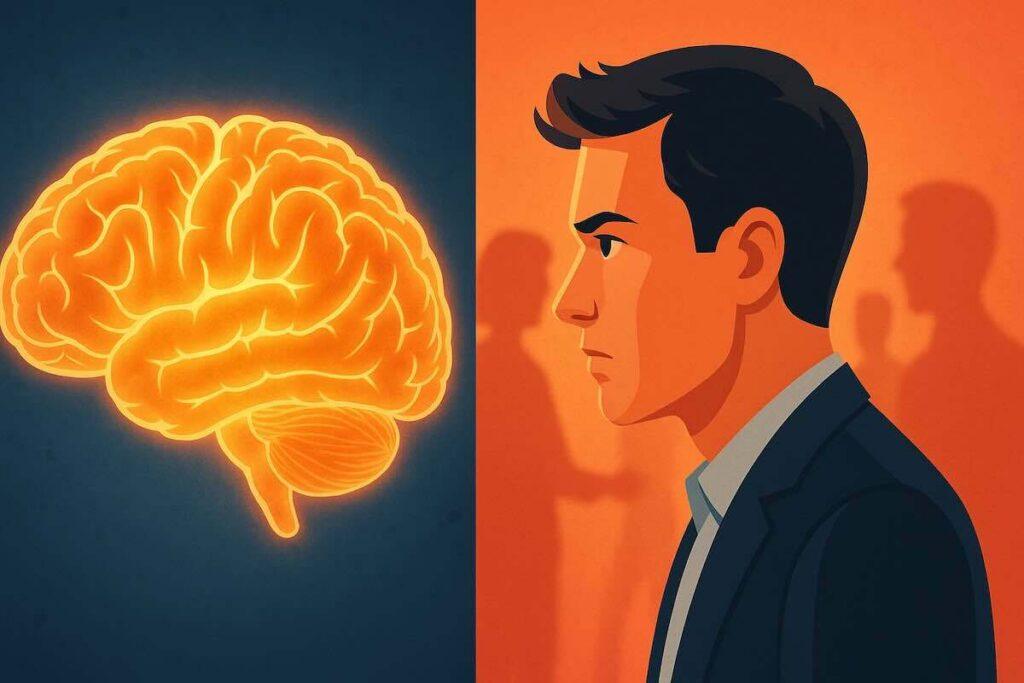
Modern neuroscience has shed light on the halo effect in our brains. Studies using functional MRI (fMRI) show that attractive or confident people trigger our brain’s reward centers. This includes the ventromedial prefrontal cortex.
This activity leads to positive thoughts about these people, even if it’s not justified. It affects our judgments of their intelligence or trustworthiness.
A study at the California Institute of Technology found something interesting. When the same face was linked to positive stories, people’s views of that person changed quickly. This shows how context can change how we see others.
This automatic emotional response is why the halo effect is hard to shake. It’s a basic part of how our brains work. Knowing about it is the first step. But using mental models can help us see past these biases.
How to Mitigate the Halo Effect in Your Decisions
While we can’t eliminate the halo effect entirely, we can take steps to reduce its influence on our judgment:
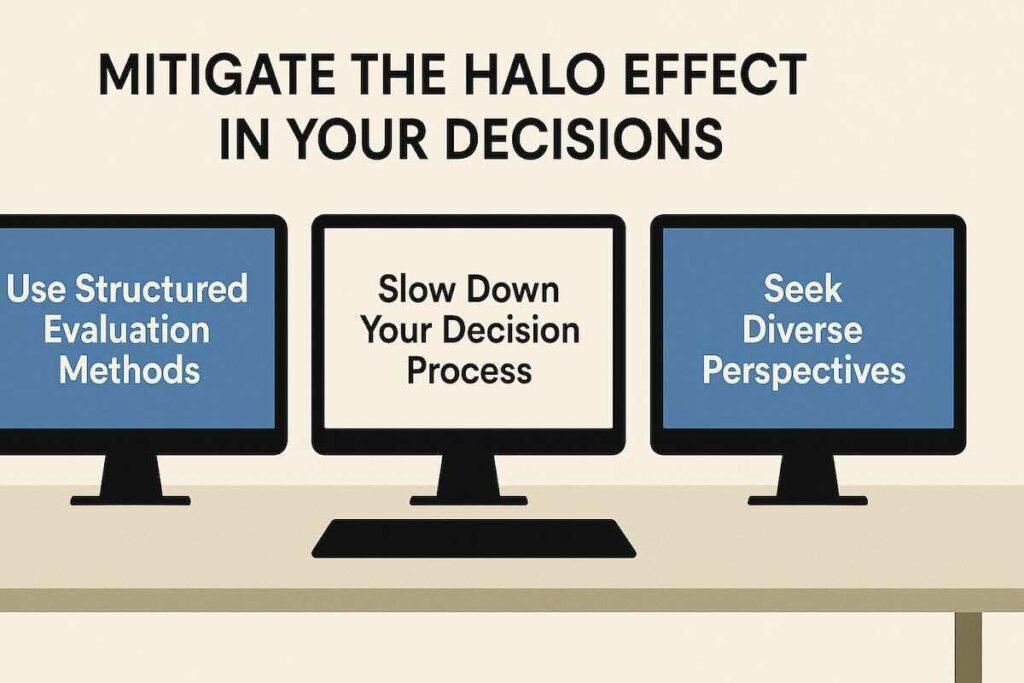
Using structured evaluation methods helps separate individual traits from overall impressions
1. Use Structured Evaluation Methods
When making important decisions about people or products, create specific criteria and evaluate each independently:
- Blind Evaluations: Remove identifying information when possible (like in resume screening or product testing)
- Rubrics and Checklists: Create detailed evaluation criteria before beginning your assessment
- Independent Ratings: Rate each quality separately before making an overall judgment
- Multiple Evaluators: Have different people assess different aspects to reduce individual bias
2. Slow Down Your Decision Process
The halo effect thrives in quick, intuitive judgments. By deliberately slowing down, you can reduce its impact:
- Take a “cooling off” period before making final decisions
- Revisit initial impressions after gathering more information
- Question your assumptions, especially when they feel automatic
- Consider the opposite: “What if my initial impression is wrong?”
3. Seek Diverse Perspectives
Other people may notice biases that you miss:
- Consult colleagues with different backgrounds and viewpoints
- Ask for specific feedback on individual traits rather than overall impressions
- Create diverse teams for important evaluation processes
Diverse teams can help identify and mitigate the influence of the halo effect
4. Practice Metacognition

- Keep a decision journal to track patterns in your judgments
- Reflect on past decisions where the halo effect may have influenced you
- Practice mindfulness to increase awareness of automatic judgments
Putting the Halo Effect Mental Model Into Practice

In Professional Settings
Apply your understanding of the halo effect to improve workplace decisions:
Hiring and Promotion
- Use structured interviews with standardized questions
- Evaluate specific skills separately from general impressions
- Consider implementing “blind” resume reviews
The Halo Effect in Performance Reviews
Performance evaluations often fall victim to halo bias. A manager might overvalue an employee’s skills because they are good at communicating. This can lead to unfair raises, promotions, and career paths.
Studies by the Society for Human Resource Management (SHRM) reveal a startling fact. Up to 60% of performance ratings are swayed by traits like likability or punctuality. This means employees who are well-liked might get better reviews, even if their work isn’t as strong.
To fight this, companies should break down performance into clear categories. They should also use detailed scoring systems. Training raters and using feedback from all angles can help reduce the halo effect’s impact.
In Personal Life
The halo effect influences many of our personal decisions:
Relationships
- Notice when you’re overlooking red flags due to positive traits
- Evaluate specific behaviors rather than making global judgments
- Seek input from trusted friends who may see what you miss
Purchases
- Research products independently of brand reputation
- Compare specific features rather than overall impressions
- Consider whether price is influencing your quality perception
How does the halo effect differ from other cognitive biases?
While many cognitive biases affect our judgment, the halo effect specifically involves allowing one trait to influence our perception of unrelated traits. It’s closely related to confirmation bias (seeking information that confirms existing beliefs) and the horn effect (the negative equivalent, where one negative trait creates a negative impression of other traits).
Can the halo effect be beneficial in certain situations?
Yes, the halo effect can sometimes be helpful as a mental shortcut when we need to make quick decisions with limited information. It allows us to form coherent impressions and reduces cognitive load. However, for important decisions, its benefits rarely outweigh the potential for error and bias.
Is the halo effect the same across all cultures?
Research suggests that while the halo effect exists across cultures, its specific manifestations vary. For example, the traits that create a “halo” differ between individualistic and collectivistic societies. In Western cultures, individual achievements might create a stronger halo, while in Eastern cultures, group harmony and relationship skills might be more influential.
Conclusion: Beyond the Halo

The halo effect mental model reminds us that perception is rarely neutral. In the age of personal branding, influencer marketing, and rapid-fire digital impressions, this bias shapes not just how we view others—but how they view us.
Understanding the mechanisms behind the halo effect gives you an edge in high-stakes environments like hiring, negotiation, leadership, and customer behavior.
By integrating this mental model into your cognitive toolkit, you create a buffer against faulty reasoning. You can pause, zoom out, and separate facts from impressions.
That doesn’t just improve decision-making—it builds credibility, fairness, and long-term strategic clarity. Note: See the availability heuristic mental model for more information about how people make snap judgments based on recent events rather than full histories.
As you continue learning about mental models, remember: our brains may take shortcuts, but we don’t have to follow them blindly.
